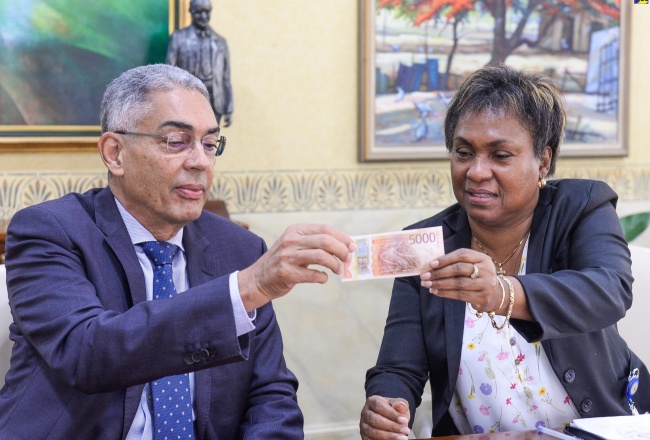Longer Lifespan for New Banknotes
By: , July 12, 2023The Full Story
The lifespan of Jamaica’s new banknotes is projected to extend by approximately 50 per cent on the timeline for the existing bills.
This projection is based on the authorities’ decision to switch the choice of material used for printing from paper to polymer.
The Bank of Jamaica (BOJ) Division Chief for Banking and Currency Operations, Chevanese Morais, tells JIS News that the polymer substrate is a thin plastic film used for banknotes and other products.
“Polymer is known for its durability. Unlike paper, it’s not easily torn [which makes it ideal] for the printing of the banknotes,” she explains.
Jamaica’s existing suite of paper-based bills comprises the $50, $100, $500, $1,000 and $5,000 denominations. These along with the newly introduced $2,000 will now be manufactured using polymer.
The BOJ formally commenced releasing the new-look denominations into circulation on June 15, following their unveiling in December 2022, with well over $11 billion already issued.
These will replace paper notes that will be gradually withdrawn by the Central Bank.
Mrs. Morais informs that the lifespan for notes printed on paper, which has been the option utilised for more than four decades, averages between one and two years.
“What our projections are indicating is that polymer will give you an extra 50 per cent on that. So now, we’re looking at the useful life of our notes being extended by at least 50 per cent [thereby making them more] long-lasting,” she adds.

Consequent on this, the polymer substrate’s utilisation is expected to substantially lower the costs associated with printing notes.
Mrs. Morais says the decision to migrate to polymer was also prompted by the material’s strong anti-counterfeiting features.
She informs that printing on the substrate requires “specialised technology and equipment” which are “extremely expensive”.
“So… in contrast to what obtains now [where counterfeiters] can just get a piece of paper and they would have… the methodology and processes that they use to capture the images from the [genuine] banknotes… you don’t have that for polymer; so that risk [of counterfeiting] is very low,” she assures.
The polymer notes feature a printed security thread to the left of the image on the front with the value of the denominations in digit format repeated vertically from top to bottom; microtext formats of the value of the denominations situated to the immediate left of the image on the back; and clear windows with printed portraits of the National Heroes and late former Prime Ministers depicted.
Each bill also has a unique tactile feature embedded which will enable the visually impaired to identify each denomination.
National Heroes, the Right Excellent Paul Bogle and George William Gordon appear on the $50 note.
Their images replace that of the Right Excellent Sam Sharpe, whose portrait has been migrated to the $500 bill to join Nanny of the Maroons.
Jamaica’s first National Hero, the Right Excellent Marcus Mosiah Garvey’s image replaces that of the country’s second Prime Minister, the Most Hon. Sir Donald Sangster, on the $100 bill.
Mr. Sangster’s image has been shifted to the $5,000 note, which previously only featured the portrait of his successor, the Most Hon. Hugh Shearer.
The portraits of Jamaica’s first Prime Minister, and National Hero, the Right Excellent Sir Alexander Bustamante, and National Hero and former Premier, the Right Excellent Norman Washington Manley, appear on the $1,000 note
These replace the image of former Prime Minister, the Most Hon. Michael Manley, which has been shifted to the $2,000, which also features the portrait of another former Head of Government, the Most Hon. Edward Seaga.
Meanwhile, the original depictions on the back of the notes have been retained. These are $50 – Doctor’s Cave Beach, $100 – Dunn’s River Falls, $500 – Port Royal, $1,000 – Jamaica House, and $5,000 – Highway 2000.
The $2,000 bill depicts an image of students of Central Branch Primary School beneath which is the National Motto – ‘Out of Many, One People’, which originally appeared on the $2 note when this denomination was previously in circulation.
Meanwhile, the BOJ is encouraging persons to exercise care when handling the new notes to ensure maximum purchase from these.
Mrs. Morais recommends that persons store the bills in a manner that prevents them from getting creased or crumpled, ideally flat, when being placed in purses and wallets.
“[Also] keep them clean. Do not write on them. Don’t use sharp objects to deface them, [in order to preserve] that attractive and pretty look [and the value], ” she adds.
Mrs. Morais advises that the extent to which the value of a damaged note is impacted and can be recouped, depends on the magnitude of the defacement.
“For example, if you bring in half of a note then you’ll be getting half of the value, once we can see the requisite serial numbers and the other features on the note. If the note is still whole and let us say you deface the clear window (the transparent segment), you’ll still get full value for it,” she tells JIS News.
Mrs. Morais emphasises, however, that “for you to get full value, of course, we have to apply our customer due diligence and our Know Your Customer (KYC) procedure”.
She indicates that these include, among other things, providing the requisite identification, “because we are very strong on anti-money laundering”.
This is the second time in Jamaica’s history that a new series of banknotes is being launched.
New notes were previously issued in 1969, seven years after the country gained political Independence from Great Britain.
The polymer notes, like the existing paper series, were manufactured by British firm, De La Rue.
The entity is the world’s largest integrated commercial banknote printer.

